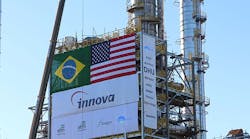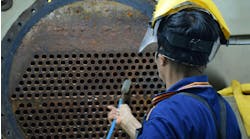Direct Heating Technology Simplifies Styrene Plant Revamp
Innova is the leading producer of styrene-based polymers in Brazil. Production at its integrated facility in Triunfo, Rio Grande do Sul, includes ethylbenzene, styrene monomer, toluene, general-purpose and high-impact polystyrenes as well as expandable polystyrene.
Originally commissioned in 2000, the styrene monomer unit had a design nameplate capacity of 180 kt/yr. As a result of catalyst improvements and equipment design margins, the unit generally could operate at capacities as high as 260 kt/yr. Given the significant demand growth for styrene-based polymers in South America, Innova in 2018 awarded a contract for the basic engineering, equipment supply and technology license to Badger Licensing (a wholly owned subsidiary of Technip Energies) to expand the plant to 390 kt/yr (more than double its original nameplate rating). Goals of the Innova expansion were to not only markedly increase throughput but also simultaneously significantly reduce energy consumption.
Here, we’ll focus on one element crucial to achieving these goals — the implementation of Badger’s “Direct Heating” technology that employs flameless combustion for adding heat to high temperature processes.
Monomer Production Process
The most widely used technology for making styrene monomer is the adiabatic dehydrogenation of ethylbenzene to styrene. Dehydrogenation occurs in the presence of excess steam over a potassium-promoted iron oxide catalyst. The dehydrogenation reaction is highly endothermic and equilibrium limited. Low pressure or high steam concentrations (or both) favor the main reaction. Steam serves to supply heat for the endothermic reaction, remove coke generated by thermal reactions, and dilute the reaction components, thus shifting equilibrium towards the desired styrene reaction. For these reasons, nearly all grassroots styrene units have two reactors in series with a steam reheat exchanger between them. The reactors operate under vacuum with inlet temperatures in the range of 600°C–650°C.
For the dehydrogenation process, given typical tradeoffs between raw material/energy consumption and capital investment, operating at the lowest possible pressure always is more economic. For revamps, minimizing the pressure drop of existing and new equipment in the reactor section is crucial. Furthermore, maximizing the throughput increase is best achieved by using the lowest practical steam-to-ethylbenzene-feed ratio, which also is best accomplished by operating at low pressure.
Project Issues
Accomplishing the goals of the Innova project required resolving three fundamental issues: 1) providing additional catalyst to achieve an economic run life; 2) minimizing the reactor operating pressure; and 3) supplying the necessary extra source of high temperature heat to drive the endothermic reaction.
The original grassroots design of the Innova reactor section consisted of two reactors in series with a steam reheat exchanger between them; two steam superheaters (one that superheats steam to the reheat exchanger and the other that heats the main steam to the first reactor); a horizontal effluent heat recovery exchanger; a cooling water condenser; and a single vent-gas compressor.
Based on historical operating data, solely using the existing two reactors to boost production would not have been economically possible. The reactors already were operating well above their design capacity; any further increase in ethylbenzene feed would result in high pressure drop, reduced conversion, catalyst instability and shortened run times. To circumvent this issue, it was decided to install a new, larger third reactor downstream of the existing ones and maintain the same ethylbenzene feed rate to the existing reactors pre- and post-revamp. The additional ethylbenzene feed would go into the effluent stream just upstream of the new third reactor. From a thermodynamic equilibrium standpoint, by converting to a three-reactor system and keeping the same overall ethylbenzene conversion to styrene, the existing reactors would operate at milder conditions (i.e., lower temperature/conversion) post-revamp.
However, hydraulically debottlenecking the effluent heat exchange train required overcoming the high pressure drop of the existing horizontal effluent heat recovery exchanger located downstream of the reactors. Because of fouling and tube plugging, the pressure drop across this horizonal exchanger would increase substantially over the course of a run, degrading performance. To alleviate this problem, a new ultra-low-pressure-drop vertical feed/effluent exchanger sized for the new higher flows was adopted. Likewise, a new condenser of greater capacity replaced the original and a second vent gas compressor was installed in parallel with the first one. In general, implementing these equipment modifications facilitated operating at the low pressure. Ultimately, even with the significantly higher flows of the revamp, the critically important reactor outlet pressure would remain about the same pre- and post-revamp.
The Direct Heating Unit
Having identified solutions for the catalyst and hydraulic limitations of the system, the engineering team then turned to finding the best way to supply high temperature heat to the system. In the three-reactor configuration, the combined ethylbenzene feed/reactor effluent stream to the new third reactor required heating to 630°C from roughly 550°C.
During the study phase of the project, the team considered conventional methods for supplying this high temperature heat; these included adding a third superheater, extending the fire box of existing heaters, and increasing the amount of feed preheating. However, in due course, the team determined that the Direct Heating option was most economical.
The Direct Heating technology resulted from years of cooperative research and development by Badger, TOTAL Petrochemical and Refining, and Shell Oil. In general, the technology takes advantage of a concept initially proposed by Shell Oil for crude oil recovery from subterranean rock formations. The Direct Heating Unit (DHU) employs the novel concept of flameless combustion — achieved by separately preheating air and fuel gas such that the mixture temperature exceeds the fuel’s autoignition temperature. Unlike conventional furnace burners that combine large amounts of fuel and air at a single point, the DHU works by adding fuel in small increments into a high velocity air stream via injections over an extended heating zone. By combining air and fuel in this way, the fuel reacts more slowly in a controlled manner and at significantly lower temperatures than in classic combustion, which gives off concentrated visible light (i.e., a flame). One advantage of using this technique in the styrene process is that the dehydrogenation reaction generates hydrogen; its relatively low autoignition temperature makes hydrogen an ideal fuel for flameless combustion.
As with most revamp projects, the team carefully considered the location of new equipment. The proposed fired superheater had to comply with both industry risk mitigation practices and insurance obligations that require fired devices to maintain minimum spacing requirements from nearby equipment containing flammable materials. At the Triunfo site, the available plot space for a new fired heater was relatively remote from the reaction section. All practical locations would call for more than 100 m of large-bore high-alloy steam piping that typically operates at over 800°C as well as numerous expensive expansion joints. From an operational standpoint, a distantly located fired heater would result in high piping heat losses and an undesirably high steam-system pressure drop.
Compelling Advantages
Conceptually, the DHU shares many characteristics of a conventional heat exchanger. However, the unit boasts a significantly smaller footprint than a fired heater (about 25% less), and doesn’t incur the above-mentioned placement constraints. So, it could be located conveniently near the existing structure. Moreover, the all-important process-side pressure drop is far lower than that of the standard reheat exchanger approach. From a safety and design simplicity standpoint, Innova particularly appreciated that the DHU design eliminated the complicated burner management system, large fire box, pilots and complex safety interlocks associated with a fired heater. In addition, because the DHU combines two unit operations (fired heater/exchanger) into a single vessel, it offers a lower total capital cost.
Based on these advantages, Innova chose to apply the novel DHU technology for its plant expansion. Following basic design, detailed engineering and commissioning, the revamped unit successfully went onstream in May 2019.
“The DHU is easy to start-up and responds well to changes in operation. The success of DHU is due to close cooperation between Innova and Badger throughout the entire project execution, start-up and day-to-day operation of the unit,” comments Wagner Debom, Innova’s plant manager.
With the change to the three-reactor system and by operating at deep vacuum conditions, Innova has decreased the weight ratio of reactor steam to ethylbenzene feed to as low as 1.02:1 from a pre-revamp average of approximately 1.5:1. Intrinsically, this translates into significant savings in fuel and steam. When combined with the distillation section upgrades, the project achieved an overall energy savings of approximately 25%.
Badger Licensing offers DHU technology for both revamp and grassroots designs. By eliminating certain temperature and metallurgical constraints of the conventional technology, it allows efficient recovery of low-level process heat and, thus, significantly reduces energy input and carbon dioxide emissions.
VINCENT WELCH is vice president and managing director of Technip Energies, Boston. Email him at [email protected].


